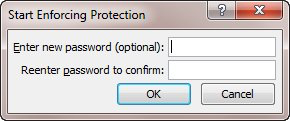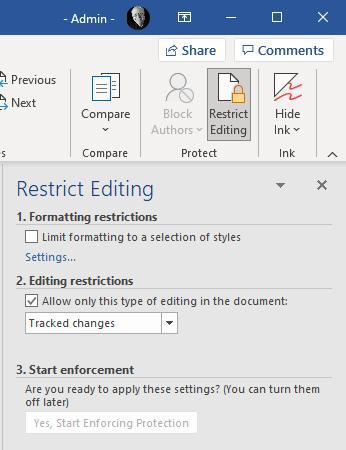Please Note: This article is written for users of the following Microsoft Word versions: 2007 and 2010. If you are using an earlier version (Word 2003 or earlier), this tip may not work for you. For a version of this tip written specifically for earlier versions of Word, click here: Protecting Tracked Changes.
Vikas has a document on which many people in his office work. The original author of the document turns on Track Changes, and then sends the document to others. Unfortunately, it is possible for other people to turn off Track Changes or to accept/reject changes done by others who previously worked on the document. Vikas wonders if there is a way that Track Changes can be locked so that only the original author can turn it off and a way that only the original author can accept/reject changes.
Theoretically, there is a way. What you need to do is to protect the document so that only tracked changes can be made by other editors. Here's how to do it:

Figure 1. The Start Enforcing Protection dialog box.
With this protection in place, people can view and edit your document with the changes being shown as regular Track Changes edits. Further, nobody can accept or reject changes without knowing the original password used to protect the document.
There is, of course, a big caveat to all of this, and it bears repeating any time people start to talk about protection. In Word, document protection will only provide protection for those who decide to "play nice." There are ways around the protection—the most notable of which is that an editor can simply copy all of the text from the edited document into a new document and start passing around that new document as if it were the original document. There is, unfortunately, no way around such behavior with Word documents.
WordTips is your source for cost-effective Microsoft Word training. (Microsoft Word is the most popular word processing software in the world.) This tip (11674) applies to Microsoft Word 2007 and 2010. You can find a version of this tip for the older menu interface of Word here: Protecting Tracked Changes.

Create Custom Apps with VBA! Discover how to extend the capabilities of Office 2013 (Word, Excel, PowerPoint, Outlook, and Access) with VBA programming, using it for writing macros, automating Office applications, and creating custom applications. Check out Mastering VBA for Office 2013 today!
Track Changes can be a great tool when you have multiple editors working on a document. If you want to know the names of ...
Discover MoreIf you want to configure how Word displays changes in your document, you may be at a loss as to where to start. This tip ...
Discover MoreMany people, when collaborating on a document with others, use the Track Changes feature to show the effects of their ...
Discover MoreFREE SERVICE: Get tips like this every week in WordTips, a free productivity newsletter. Enter your address and click "Subscribe."
2021-05-26 10:04:02
Lee McIntyre
Thanks, Allen. The steps aren't quite the same using Word 365. In the "Protect" group, we select "Restrict Editing" rather than "Protect Document."
But more importantly, the "Yes, Start Enforcing Protection" option is grayed out. See the screenshot: (see Figure 1 below)
What am I doing wrong?

Figure 1.
2018-01-05 11:08:33
Marisa
This tip does not accurately reflect the Review tab in Word 2010. The button Protect Document in Word 2007 is called Restrict Editing in Word 2010.
Got a version of Word that uses the ribbon interface (Word 2007 or later)? This site is for you! If you use an earlier version of Word, visit our WordTips site focusing on the menu interface.
Visit the WordTips channel on YouTube
FREE SERVICE: Get tips like this every week in WordTips, a free productivity newsletter. Enter your address and click "Subscribe."
Copyright © 2024 Sharon Parq Associates, Inc.
Comments